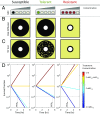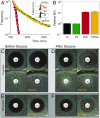Epistasis between antibiotic tolerance, persistence, and resistance mutations
- PMID: 31262806
- PMCID: PMC6642377
- DOI: 10.1073/pnas.1906169116
Epistasis between antibiotic tolerance, persistence, and resistance mutations
Abstract
Understanding the evolution of microorganisms under antibiotic treatments is a burning issue. Typically, several resistance mutations can accumulate under antibiotic treatment, and the way in which resistance mutations interact, i.e., epistasis, has been extensively studied. We recently showed that the evolution of antibiotic resistance in Escherichia coli is facilitated by the early appearance of tolerance mutations. In contrast to resistance, which reduces the effectiveness of the drug concentration, tolerance increases resilience to antibiotic treatment duration in a nonspecific way, for example when bacteria transiently arrest their growth. Both result in increased survival under antibiotics, but the interaction between resistance and tolerance mutations has not been studied. Here, we extend our analysis to include the evolution of a different type of tolerance and a different antibiotic class and measure experimentally the epistasis between tolerance and resistance mutations. We derive the expected model for the effect of tolerance and resistance mutations on the dynamics of survival under antibiotic treatment. We find that the interaction between resistance and tolerance mutations is synergistic in strains evolved under intermittent antibiotic treatment. We extend our analysis to mutations that result in antibiotic persistence, i.e., to tolerance that is conferred only on a subpopulation of cells. We show that even when this population heterogeneity is included in our analysis, a synergistic interaction between antibiotic persistence and resistance mutations remains. We expect our general framework for the epistasis in killing conditions to be relevant for other systems as well, such as bacteria exposed to phages or cancer cells under treatment.
Keywords: antibiotic persistence; antimicrobials; evolution of resistance; killing assay; synergy.
Copyright © 2019 the Author(s). Published by PNAS.
Conflict of interest statement
Conflict of interest statement: N.Q.B. and B.R.L. are coauthors on a Consensus Statement [Nature Rev. Microbiol. 17, 441–448 (2019) doi: 10.1038/s41579-019-0196-3].
Figures






References
-
- Lewis K., Persister cells, dormancy and infectious disease. Nat. Rev. Microbiol. 5, 48–56 (2007). - PubMed
-
- Levin B. R., Rozen D. E., Non-inherited antibiotic resistance. Nat. Rev. Microbiol. 4, 556–562 (2006). - PubMed
-
- Brauner A., Fridman O., Gefen O., Balaban N. Q., Distinguishing between resistance, tolerance and persistence to antibiotic treatment. Nat. Rev. Microbiol. 14, 320–330 (2016). - PubMed
-
- Scholar E. M., Pratt W. B., The Antimicrobial Drugs (Oxford University Press, 2000).
-
- Andrews J. M., Determination of minimum inhibitory concentrations. J. Antimicrob. Chemother. 48 (suppl. 1), 5–16 (2001). Erratum in: J. Antimicrob. Chemother.49, 1049 (2002). - PubMed
Publication types
MeSH terms
Substances
LinkOut - more resources
Full Text Sources
Medical

